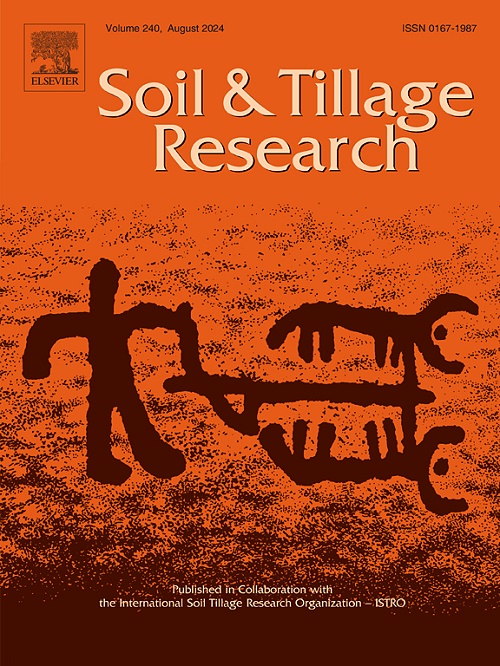Legume-based rotation benefits crop productivity and agricultural sustainability in the North China Plain
IF 6.1
1区 农林科学
Q1 SOIL SCIENCE
引用次数: 0
Abstract
Diversified rotation through legume inclusion supports sustainable crop production and reduces environmental risks, representing a key strategy for sustainable agriculture. However, the impacts of legume-based rotation on cropping system productivity and carbon (C) emissions have not been thoroughly investigated. Here, a field experiment was conducted to examine the impacts of three cropping systems (peanut-wheat, soybean-wheat vs. maize-wheat rotation) and two fertilization treatments (with and without fertilization) on crop yield, C footprint (CF), and agricultural sustainability. Our findings revealed that legume inclusion resulted in a higher crop yield (+40 % on average) than maize-wheat, and the yield advantage was 80% higher without than with fertilization. This demonstrated the effectiveness of legumes in enhancing crop production under low-input conditions. Legume inclusion enhanced the annual net income by 2.8 times over maize-wheat under no fertilization, while income declined by 20 % under fertilization. Notably, compared to maize-wheat, the direct greenhouse gas (GHG) emissions under legume-wheat decreased by 43 %, while indirect GHG emissions showed no significant difference. Furthermore, legume inclusion mitigated soil C stock loss by 1579 (kg C ha−1 yr−1) under no fertilization and increased soil C stock by 3766 (kg C ha−1 yr−1) under fertilization, further reducing the CF (-31 %) and enhancing the agricultural sustainability (+86 %). In conclusion, our study indicates that legume-based rotation represents a vital strategy for promoting sustainable crop production and environmental advantages, particularly within low-input agricultural systems.
以豆类为主的轮作有利于华北平原的作物生产力和农业可持续性
纳入豆科植物的多样化轮作支持可持续作物生产并降低环境风险,是可持续农业的一项关键战略。然而,以豆科植物为基础的轮作对耕作系统生产力和碳(C)排放的影响尚未得到深入研究。在此,我们进行了一项田间试验,研究三种种植系统(花生-小麦、大豆-小麦与玉米-小麦轮作)和两种施肥处理(施肥与不施肥)对作物产量、碳足迹(CF)和农业可持续性的影响。我们的研究结果表明,与玉米-小麦相比,加入豆科植物的作物产量更高(平均高出 40%),而且不施肥的产量优势比施肥高出 80%。这证明了豆科植物在低投入条件下提高作物产量的有效性。在不施肥的情况下,豆科植物的年纯收入比玉米-小麦提高了 2.8 倍,而施肥的情况下,收入下降了 20%。值得注意的是,与玉米-小麦相比,豆科植物-小麦的直接温室气体(GHG)排放量减少了 43%,而间接温室气体排放量没有显著差异。此外,在不施肥的情况下,加入豆科植物可减少土壤碳储量损失 1579(千克碳公顷-1 年-1),而在施肥的情况下,可增加土壤碳储量 3766(千克碳公顷-1 年-1),从而进一步减少温室气体排放量(-31%),提高农业可持续性(+86%)。总之,我们的研究表明,以豆科植物为基础的轮作是促进可持续作物生产和环境优势的重要策略,尤其是在低投入农业系统中。
本文章由计算机程序翻译,如有差异,请以英文原文为准。
求助全文
约1分钟内获得全文
求助全文
来源期刊

Soil & Tillage Research
农林科学-土壤科学
CiteScore
13.00
自引率
6.20%
发文量
266
审稿时长
5 months
期刊介绍:
Soil & Tillage Research examines the physical, chemical and biological changes in the soil caused by tillage and field traffic. Manuscripts will be considered on aspects of soil science, physics, technology, mechanization and applied engineering for a sustainable balance among productivity, environmental quality and profitability. The following are examples of suitable topics within the scope of the journal of Soil and Tillage Research:
The agricultural and biosystems engineering associated with tillage (including no-tillage, reduced-tillage and direct drilling), irrigation and drainage, crops and crop rotations, fertilization, rehabilitation of mine spoils and processes used to modify soils. Soil change effects on establishment and yield of crops, growth of plants and roots, structure and erosion of soil, cycling of carbon and nutrients, greenhouse gas emissions, leaching, runoff and other processes that affect environmental quality. Characterization or modeling of tillage and field traffic responses, soil, climate, or topographic effects, soil deformation processes, tillage tools, traction devices, energy requirements, economics, surface and subsurface water quality effects, tillage effects on weed, pest and disease control, and their interactions.
 求助内容:
求助内容: 应助结果提醒方式:
应助结果提醒方式:


